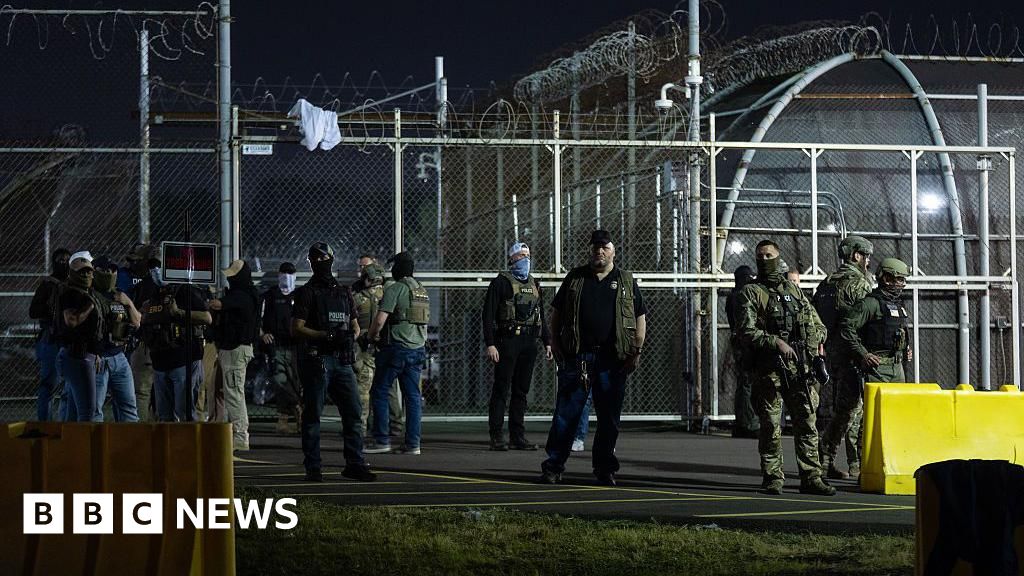ARTICLE AD BOX
Disruptive winter storm moves across North America
By Sam Cabral
BBC News, Washington
A massive winter storm will blanket US cities from coast to coast this week, even as it will feel like early summer in other parts of the country.
More than 30 million people in 22 states are under winter weather alerts as of Tuesday, bracing for a mix of heavy snow, rain and wind.
The National Weather Service (NWS) has warned the storm will be "extremely disruptive" to those in affected areas.
But unseasonably warm conditions are forecast for millions more Americans.
The NWS expects widespread travel disruptions in storm affected regions. Delta, Southwest, and United Airlines said any additional fees will be waived for travellers who may need to rebook flights in certain areas due to weather.
Here's what you need to know:
High snowfall in California
Winter weather alerts extend from California to Maine, with mountain ranges across the US west expecting up to two feet (61cm) of snow.
The effects of the storm were already being felt on Monday across the Cascades and Northern Rockies mountain ranges in the country's northwest.
The heavy snow and strong winds are spreading south and east, and could include Los Angeles and parts of southwest California.
LA will experience "the coldest storm of the season, and possibly of the last several years," according to its local NWS office.
Gale force winds accompanied by extremely cold air are expected through Wednesday, and high surf may create dangerous conditions along the coast through Thursday.
Graupel - also called snow pellets or soft hail - is also forecast in elevated parts of the state.
Blizzard conditions in Minnesota
The storm is expected to intensify as it sweeps east, dumping snow at a rate of up to two inches (5cm) per hour across the High Plains, upper Midwest and Great Lakes regions.
"By late Tuesday night and more exceptionally on Wednesday, the major winter storm will take shape and spread tremendous snowfall, both in coverage, rates, and amounts," the weather service said.
Blizzard warnings have been issued in portions of Wyoming, Montana, South Dakota, Iowa and Minnesota.
Minnesota faces the likelihood of gusty winds and one of the city's top three snowfall events of all time - as much as 25 inches (64cm) from Tuesday through Thursday.
The weather service for the Minneapolis-Twin Cities area has warned of "life-threatening travel disruptions" as well as potential power outages and tree damage.
Freezing rain and thunderstorms
Heavy rainfall and severe thunderstorms are forecast for Tuesday and Wednesday in the Midwest and Upper Plains, from Oklahoma through Ohio.
Icy roads may cause concern as the winter storm system moves northeast later in the week.
Much of the northeast region has seen little snow accumulation this winter, but could see freezing rain and ice from Wednesday through Friday.
Parts of Maine, New Hampshire, New York and Vermont are on alert for a winter storm.
Additionally, an area from northern Texas to western Illinois faces a slight tornado risk.
Image source, Getty Images
Image caption,Ice-cream weather for many in the month of February in Manhattan, New York
Record highs and record lows
Temperatures will hit record highs for the month of February in hundreds of US cities across the Southeast, mid-Atlantic and eastern seaboard.
Cities like Atlanta, Georgia and Nashville, Tennessee will see temperatures reach about 77F (25C) by Thursday, while cities in Florida could hit peaks above 86F (30C) - usually not seen until May or June.
Other parts of the country will simultaneously face record lows, with temperature readings five degrees colder than average in parts of Montana, Wyoming and Nebraska.
Forecasters say this pattern of anomalous weather is expected to remain in place for at least the next few weeks.
Why is this happening?
North America typically faces dynamic jet stream patterns during the winter that create a battleground of cold and warm air.
But jet streams this winter have been "more extreme", and have been accompanied by ample moisture from the Pacific Ocean and the Gulf of Mexico, according to climate scientist Andrew Kruczkiewicz.
"All winter, we've seen this persistent pattern, where the western US is seeing below-average temperatures and the eastern US is seeing above-average temperatures," he told the BBC.
"What makes this week different is that we're seeing an intensification of the pattern."
Mr Kruczkiewicz, a researcher at Columbia University, said the extreme weather event's length and severity will be studied for its connection to climate change.

 2 years ago
54
2 years ago
54








 English (US) ·
English (US) ·